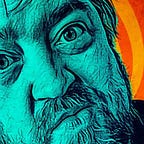Our grandiose lives
We want larger than life stories to remember the simple things
I’ve gone off the beaten track for the past couple of emails. And it’s time to get back to Ong and his characteristics of oral cultures. And today, we’re going to look at
The noetic role of heroic ‘heavy’ figures and of the bizarre
In this, Ong focuses on the tall tale.
The absurd and larger-than-life heroes and characters, in oral cultures, aren’t as grandiose as they seem. Their extreme nature is normalized & memorized over time.
In fiction
It’s easy to see this in fiction, the larger-than-life images and situations we watch. With advancements in technology and CG, there is an almost infinite rabbit hole we can take ourselves.
For the longest time in our literate culture, books have held these grandiose images and stories. Then came the moving pictures. To me, it seems appropriate that some of the earliest attempts to catch our imaginations were centred around flying to the moon or robots and androids.
Most of the great stories have elements of the absurd, bizarre, larger-than-life characters and journey. They stick with you.
And not only that — they have an immediate word-of-mouth quality.
In a story with a million over-the-top moments and characters, when recounted and told to friends and family, if you miss a part, a feature, it still can captivate. The heart of the story travels, even if you don’t know exactly how big or green The Hulk is.
For fiction to be grandiose is expected. What’s really difficult to think about is what’s next: the “real” world.
In Fact
In 15–20 years, what will we remember about these past few years?
It might depend on how many fictionalized movies come out.
Over the past few years, I’ve seen an interesting trend that, I think, relates to this thought — the fictionalization of history.
Take a look at these two lists, biographical films and biographical mini-series. I smashed them together to get this.
We are creating & consuming our history more and more through infotainment.
Some could argue that this isn’t real history. That these fictionalized moments are outlandish, over-the-top, made for our viewing pleasure. But maybe at the root, that’s the point. Make history bizarre, outlandish, and grandiose, and maybe we’ll actually remember a nugget of truth?
I’ll admit, my napkin numbers may be reflective more about technology. That the cost to make TV and movies is decreasing, so that overall more content is made in general.
But as I think about it, does this really sway the thought? How many books are there fictionalizing history? Is the history that we learn (not the journalistic history of historians) all but a story?
Perhaps TV & movies, by their very nature, allow for the outlandish, bizarre, dramatized life for our viewing pleasure. They are designed to recreate larger-than-life moments “on the big screen,” which is kinda why we like it.
Now for the kicker
We take in all this over-the-top content, and over time, what happens?
The absurd and outlandish fade, and the nugget of a moral, thought, or feeling remains.
Ong doesn’t oppose this outlandish and bizarre, only that in oral cultures, it was more prominent. He even mentioned that in literature, this continues. However, it’s an artifact of an oral culture. It was heavily required for an oral society as a tool to normalize information through society over time.
The postliterate
The “heroic” heavy figure, the Ong notes, fades with literate culture. Over time there came the “anti-hero,” that “you do not need a hero in the old sense to mobilize knowledge in story form.”
I can’t entirely agree that there was always a heavy hero. In several storytelling traditions, more complex figures took center stage. Take the trickster, the raven, the coyote, Loki, Kaulu, Mercury, the Monkey King, and more.
Let’s look at the gods of Rome or the Norse — sure, magnificent and over the top with grand powers and bizarre and otherworldly experiences — yet flawed and almost human. They were, as Ong might call them, “heavy” figures, but all heroic? No.
How about the Indigenous peoples of North America whose, for lack of a better word, gods were animals and nature itself. “Heavy” figures? Yes. Heroic? Not all.
If Ong was right about needing a hero, though I disagree, perhaps in the post-literate the “heavy” figures are not an external hero, but ourselves. Celebrities taking the limelight. While the rest stage our lives to be bigger, to be more outlandish, to be more grandiose than they are. All with the idea to be seen, and maybe what’s harder to acknowledge, to be remembered.
Though, perhaps this is a transition? Maybe we’re stewing and creating the recipe to create a new set of Roman and Norse-like gods. People who may actually have been real at one point in time, only to have their lives made bizarre and over-the-top from some sort of common societal draw.
